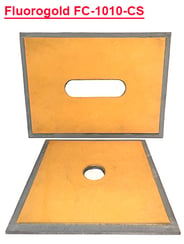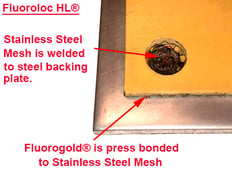They will be found on plans for everything from offshore drilling platforms, big box stores, renovations, or any structure where the stress of movement, expansion and contraction needs to be relieved.
There are endless configurations and designs to adapt to whatever conditions are present.
In their simplest and most common form the assembly is made of an upper and lower plate, with the upper being the moving member and the lower being fixed.
From there designs will vary based on the conditions the bearing assembly will be subjected to. Slide Bearing diagrams can be seen here.
Operating temperatures will be a major consideration. The standard Fluorogold® FC-1010-CS will serve under temperatures up to 400°F. If the temperature increases beyond that a designer should look to Fluoroloc HL, which is mechanically bonded, not glued. As temperatures continue increasing the design will incorporate an insulated separator in a Fluorotemp bearing assembly with service temperatures up to 1,000°F.
Horizontal Rotation or “flex”, as in the case of bridges or overpasses where continual deflection needs to be addressed. See FC-1010-CS 1/4 NRT.
Working Load Weight will play an important role in determining the dimensions. It is important to target the correct load range to allow the Fluorogold® surface to self-lubricate.
Teflon® and Fluorogold Slide Bearings®
 Note: Teflon® and Fluorogold® will function similarly, with nearly equal co-efficients of friction. The difference is in the make up of the material. Fluorogold® is Teflon® based with fiberglass infused to add durability. This becomes especially important in exterior applications such as oil pipelines, drilling platforms, or anywhere contaminants could be present and act as abrasives on the sliding surface. From a cost perspective, Fluorogold and Teflon are approximately equal so frequently architects and designs will default to Fluorogold® in all their slide bearing applications
Note: Teflon® and Fluorogold® will function similarly, with nearly equal co-efficients of friction. The difference is in the make up of the material. Fluorogold® is Teflon® based with fiberglass infused to add durability. This becomes especially important in exterior applications such as oil pipelines, drilling platforms, or anywhere contaminants could be present and act as abrasives on the sliding surface. From a cost perspective, Fluorogold and Teflon are approximately equal so frequently architects and designs will default to Fluorogold® in all their slide bearing applications




